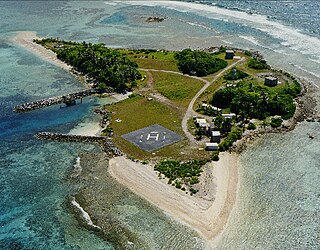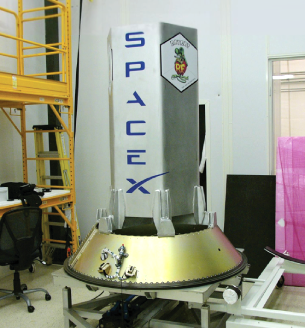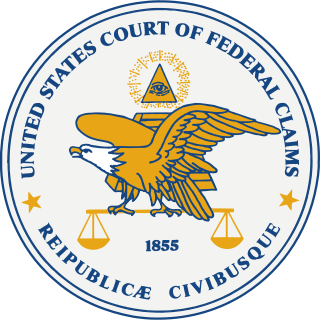Related Research Articles

Space Exploration Technologies Corp., commonly referred to as SpaceX, is an American spacecraft manufacturer, launch service provider, defense contractor and satellite communications company headquartered in Hawthorne, California. The company was founded in 2002 by Elon Musk with the goal of reducing space transportation costs and ultimately developing a sustainable colony on Mars. The company currently operates the Falcon 9 and Falcon Heavy rockets along with the Dragon and Starship spacecraft.

Falcon 1 was a small-lift launch vehicle that was operated from 2006 to 2009 by SpaceX, an American aerospace manufacturer. On 28 September 2008, Falcon 1 became the first privately developed fully liquid-fueled launch vehicle to go into orbit around the Earth.

Elon Reeve Musk is a businessman and investor. He is the founder, chairman, CEO, and CTO of SpaceX; angel investor, CEO, product architect, and former chairman of Tesla, Inc.; owner, executive chairman, and CTO of X Corp.; founder of the Boring Company and xAI; co-founder of Neuralink and OpenAI; and president of the Musk Foundation. He is one of the wealthiest people in the world, with an estimated net worth of US$190 billion as of March 2024, according to the Bloomberg Billionaires Index, and $195 billion according to Forbes, primarily from his ownership stakes in Tesla and SpaceX.

Omelek Island is part of the Kwajalein Atoll in the Republic of the Marshall Islands. It is controlled by the United States military under a long-term lease and is part of the Ronald Reagan Ballistic Missile Defense Test Site.

The Global Forecast System (GFS) is a global numerical weather prediction system containing a global computer model and variational analysis run by the United States' National Weather Service (NWS).

RatSat or DemoSat was an aluminum mass simulator on the fourth flight of the Falcon 1 rocket, launched on 28 September 2008. Ratsat remained bolted to the second stage of the carrier rocket after reaching low Earth orbit. It is an aluminium alloy chamber in hexagonal prism shape with 1.5 m (5 ft) length.

Gwynne Shotwell is an American businesswoman and engineer. She is the president and chief operating officer of SpaceX, an American space transportation company, where she is responsible for day-to-day operations and company growth.

Falcon Heavy is a partially reusable super heavy-lift launch vehicle that can carry cargo into Earth orbit, and beyond. It is designed, manufactured and launched by American aerospace company SpaceX.

SpaceX has privately funded the development of orbital launch systems that can be reused many times, similar to the reusability of aircraft. SpaceX has developed technologies over the last decade to facilitate full and rapid reuse of space launch vehicles. The project's long-term objectives include returning a launch vehicle first stage to the launch site within minutes and to return a second stage to the launch pad, following orbital realignment with the launch site and atmospheric reentry in up to 24 hours. SpaceX's long term goal would have been reusability of both stages of their orbital launch vehicle, and the first stage would be designed to allow reuse a few hours after return. Development of reusable second stages for Falcon 9 was later abandoned in favor of developing Starship, however, SpaceX developed reusable payload fairings for the Falcon 9.

SpaceX CRS-8, also known as SpX-8, was a Commercial Resupply Service mission to the International Space Station (ISS) which was launched on April 8, 2016, at 20:43 UTC. It was the 23rd flight of a Falcon 9 rocket, the tenth flight of a Dragon cargo spacecraft and the eighth operational mission contracted to SpaceX by NASA under the Commercial Resupply Services program. The capsule carried over 3,100 kilograms (6,800 lb) of cargo to the ISS including the Bigelow Expandable Activity Module (BEAM), a prototype inflatable space habitat delivered in the vehicle's trunk, which was attached to the station and, as of May 2022, is expected to remain so for five more full years of in-orbit viability tests.

SpaceX has stated its ambition to facilitate the colonization of Mars via the development of the Starship launch vehicle. The company states that this is necessary for the long-term survival of the human species.

Boca Chica Village or Kopernik Shores, formerly Kennedy Shores, is a small unincorporated community in Cameron County, Texas, United States. It was formed in the late 1960s, and is still extant as of 2021, although the village proper has changed greatly since 2018 as SpaceX came to purchase much of the land of the village. It lies 20 miles (32 km) east of the City of Brownsville on the Boca Chica peninsula, and forms part of the Brownsville–Harlingen–Raymondville and the Matamoros–Brownsville metropolitan areas. It is situated on Texas State Highway 4, immediately south of the South Bay lagoon, and is located about 2 mi (3.2 km) northwest of the mouth of the Rio Grande. Although the name Kopernik Shores is no longer in popular use, it remains its official name per the U.S. Board on Geographic Names, and is still occasionally used in official contexts.
The Mars race, race to Mars or race for Mars is the competitive environment between various national space agencies, "New Space" and aerospace manufacturers involving crewed missions to Mars, land on Mars, or set a crewed base there. Some of these efforts are part of a greater Mars colonization vision, while others are for glory, or scientific endeavours. Some of this competitiveness is part of the New Space race.

This is a corporate history of SpaceX, an American aerospace manufacturer and spacetransport services company founded by Elon Musk.

Starship is a two-stage super heavy lift launch vehicle under development by American aerospace company SpaceX. It is the largest and most powerful rocket ever flown. Starship is intended to be fully reusable, allowing both stages to be recovered after a mission and to be rapidly reused. SpaceX has stated that a long-term goal for the Starship system is to achieve frequent space launches at low cost. Development follows an iterative and incremental approach, involving often destructive test flights of prototype vehicles.
SpaceX Starship flight tests include eleven launches of prototypes of the Starship spacecraft on sub-orbital and low-altitude tests, and three orbital trajectory flights of the entire Starship launch vehicle with a Starship prototype atop a Super Heavy first-stage booster. Designed and operated by private manufacturer SpaceX, the flown prototypes of Starship so far are Starhopper, SN5, SN6, SN8, SN9, SN10, SN11, SN15, Ship 24/B7, Ship 25/B9, and Ship 28/B10.

Starship HLS is a lunar lander variant of the Starship spacecraft that is slated to transfer astronauts from a lunar orbit to the surface of the Moon and back. It is being designed and built by SpaceX under the Human Landing System contract to NASA as a critical element of NASA's Artemis program to land a crew on the Moon.

On 13 August 2021, Blue Origin filed a complaint to the United States Court of Federal Claims about NASA's award of $2.9 billion to SpaceX. The award was used by the company to further develop Starship HLS, a lunar lander that NASA selected for the Artemis program. On 4 November 2021, the Court of Federal Claims dismissed the complaint, and the accompanying memorandum opinion was titled Blue Origin v. United States & Space Exploration Technologies Corp. Blue Origin's complaint and prior actions have received attention from the news media and spaceflight industries.

SpaceX Starship integrated flight test 1 (IFT-1) was the first integrated flight test of the SpaceX Starship launch vehicle. SpaceX performed the flight test on April 20, 2023. The prototype vehicle was destroyed less than four minutes after lifting off from the SpaceX Starbase in Boca Chica, Texas. The vehicle became the most powerful rocket ever flown, breaking the half-century-old record held by the Soviet Union's N1 rocket.
Before settling on the 2018 Starship design, SpaceX successively presented a number of reusable super-heavy lift vehicle proposals. These preliminary spacecraft designs were known under various names.
References
- ↑ Hixenbaugh, Mike; Hunn, David; Collette, Mark (September 2, 2017). "Terror, heartbreak and heroism as five Houstonians brave America's worst storm". Houston Chronicle. Archived from the original on June 3, 2021. Retrieved September 8, 2021.
- ↑ Anthony Colangelo & Jake Robins (February 16, 2023). "Episode 95 - Horsesh (with Eric Berger)". Off-Nominal (Podcast). Event occurs at 04:02. Retrieved February 19, 2023.
- 1 2 3 4 5 6 7 Jones, Chris (December 20, 2017). "Meet the Unlikely Hero Who Predicted Hurricane Harvey's Floods". Wired . Archived from the original on August 30, 2021. Retrieved August 30, 2021.
- ↑ Airhart, Marc G. "Alumnus Eric Berger Reflects on the Joys of Science Communication". Archived from the original on September 6, 2021. Retrieved September 6, 2021.
- ↑ Mackey, Weezie. "Rain Man". Jones Graduate School of Business at Rice University. Archived from the original on September 6, 2021. Retrieved September 6, 2021.
- 1 2 3 Hardy, Michael (June 29, 2021). "Eric Berger Knows Which Way the Wind Blows" . Texas Monthly . Archived from the original on August 30, 2021. Retrieved August 30, 2021.
- ↑ Balke, Jeff (June 13, 2012). "Know Your Local Media: The Chron's Eric Berger on Hurricanes, Climate Change and Evacuating Katy". Houston Press . Archived from the original on September 6, 2021. Retrieved September 6, 2021.
- ↑ Delaney, Edward J. "Breaking news online: How two Pulitzer finalists used the web". Nieman Journalism Lab . Archived from the original on September 6, 2021. Retrieved September 6, 2021.
- 1 2 Welch, Monique (June 8, 2021). "Houston officially declares today, June 8, as Space City Weather Day". Houston Chronicle. Archived from the original on August 30, 2021. Retrieved August 30, 2021.
- ↑ "Liftoff: Elon Musk and the Desperate Early Days that Launched SpaceX". Publishers Weekly . February 17, 2021. Archived from the original on September 6, 2021. Retrieved September 6, 2021.
- ↑ "Liftoff". Kirkus Reviews . January 6, 2021. Archived from the original on September 6, 2021. Retrieved September 6, 2021.
- ↑ Thornhill, John (April 7, 2021). "Liftoff by Eric Berger — Musk's otherworldly ambition". Financial Times . Archived from the original on September 6, 2021. Retrieved September 6, 2021.